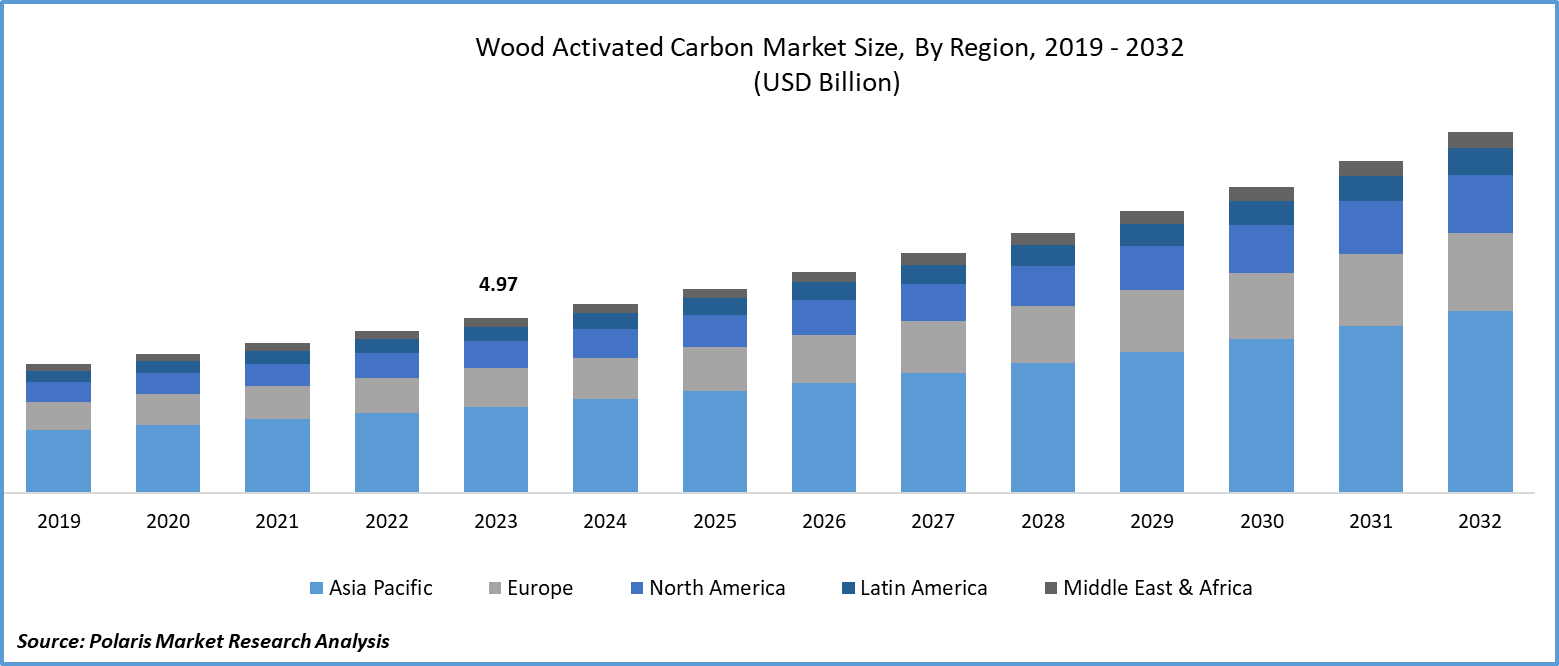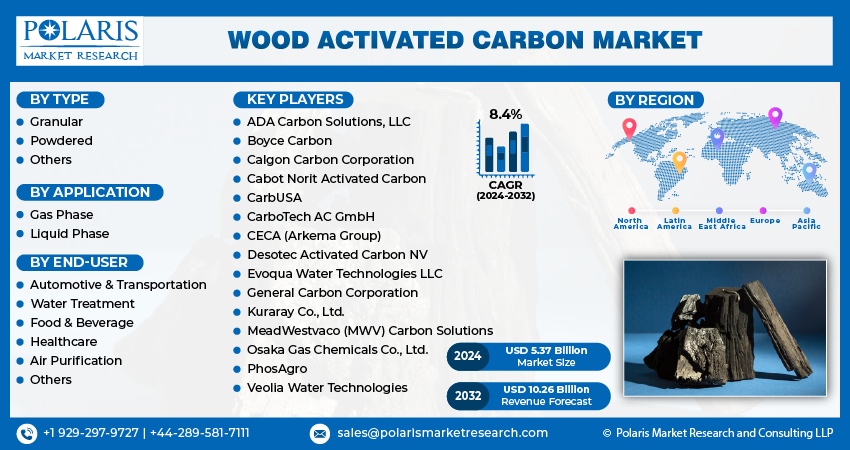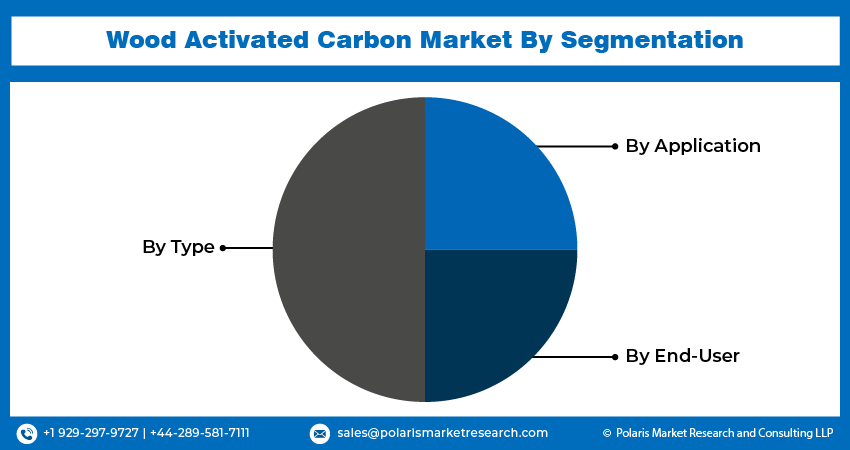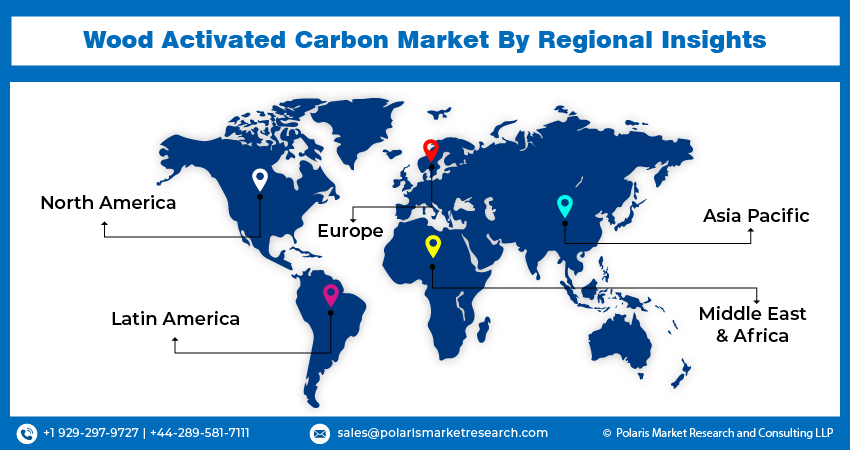
Wood Activated Carbon Market Share, Size, Trends, Industry Analysis Report, By Type (Granular, Powdered, Others); By Application (Gas Phase, Liquid Phase); By End-User; By Region; Segment Forecast, 2024 - 2032
- Published Date:Feb-2024
- Pages: 118
- Format: PDF
- Report ID: PM4320
- Base Year: 2023
- Historical Data: 2019 – 2022
Report Outlook
The global wood activated carbon market was valued at USD 4.97 billion in 2023 and is expected to grow at a CAGR of 8.4% during the forecast period.
The need for environmental solutions, water and air purification, and sustainable resources drives the wood activated carbon market. Despite some restraints, ongoing innovation and expanding applications offer significant opportunities for growth in this dynamic market. As the world continues to focus on sustainability and environmental responsibility, wood activated carbon is likely to play an increasingly essential role in addressing pollution and purification challenges across various industries.
The growing global emphasis on environmentally sustainable products has been a significant catalyst in the expansion of the wood activated carbon market. Derived from renewable resources, wood-based activated carbon aligns seamlessly with eco-friendly manufacturing and sustainable sourcing principles, resulting in a diminished environmental footprint.
Wood activated carbon finds extensive application in the purification of water and wastewater, where it effectively eliminates impurities, odorous compounds, and contaminants. This has made a constructive contribution to elevating the quality of potable water and the management of industrial effluents, ultimately leading to the assurance of cleaner water resources and healthier environments.

To Understand More About this Research: Request a Free Sample Report
- For instance, in February 2023, Evoqua Water Technologies entered into a collaboration with DESOTEC for the transfer of its slurry operations and carbon reactivation.
However, the price of wood activated carbon can fluctuate due to factors such as raw material costs, production processes, and market demand. This volatility can impact profitability and market stability. Wood activated carbon faces competition from alternative materials, including coconut shell-based activated carbon and pelletized activated carbon. These alternatives may offer different cost-performance trade-offs. Also, the carbonization process of wood activated carbon can be energy-intensive, leading to higher production costs. Thus hampering the growth of wood activated carbon market.
Growth Drivers
Increasing stringent environmental regulations is projected to spur the product demand.
Increasing environmental regulations and standards worldwide mandate the removal of pollutants and contaminants from air and water. Wood activated carbon is a preferred choice for compliance with these regulations due to its effectiveness and sustainability. The expanding population and industrialization have intensified the need for clean water. Wood activated carbon plays a crucial role in water treatment, as it efficiently removes impurities, organic compounds, and toxins, ensuring safe and potable water sources.
Moreover, growing concerns over air quality, especially in urban areas, drive the adoption of wood activated carbon in air purification systems. Its ability to adsorb volatile organic compounds (VOCs), odors, and pollutants enhances indoor and outdoor air quality.

Report Segmentation
The market is primarily segmented based on type, application end-user, and region.
|
By Type |
By Application |
By End-User |
By Region |
|
|
|
|
To Understand the Scope of this Report: Speak to Analyst
By Type Analysis
Granular segment is expected to witness highest growth during forecast period
The granular segment within the wood activated carbon market is experiencing remarkable growth. Granular wood activated carbon, characterized by its larger particle size and extensive surface area, has found wide-ranging applications that are driving its expansion.
First and foremost, it excels in water and wastewater treatment, effectively removing impurities, contaminants, and odors. Its efficiency in adsorption makes it indispensable for improving water quality and ensuring safe drinking water. Moreover, granular wood activated carbon is increasingly utilized in air purification systems to combat volatile organic compounds (VOCs), enhancing both indoor and outdoor air quality.
Its versatility extends to diverse industrial applications, from pharmaceuticals to food and beverage, for purification and decontamination processes. The customization options offered by manufacturers further fuel its growth, enabling tailored solutions for specific industries. In a world with growing environmental concerns and stringent regulations, the granular wood activated carbon segment is poised for continued expansion as it addresses the pressing need for sustainability and pollution control.
By Application Analysis
Gas phase segment accounted for the largest market share in 2022
The gas phase segment accounted for the largest market share in 2022 and is likely to retain its market position throughout the forecast period. Gas phase wood activated carbon, renowned for its high absorption capacity and efficiency in capturing gaseous pollutants, is witnessing increased demand in diverse applications.
One significant driver is its utilization in industrial gas purification, where it effectively removes noxious gases and impurities from manufacturing processes, ensuring environmental compliance and worker safety. Furthermore, its deployment in gas masks and respirators for personal protection against harmful airborne substances is expanding.
The gas phase wood activated carbon segment's growth is closely linked to the surging focus on air quality and emissions control. It plays a crucial role in combatting indoor and outdoor air pollution by adsorbing volatile organic compounds (VOCs) and other airborne contaminants. As environmental regulations become more stringent, the gas phase segment is expected to continue its expansion, safeguarding air quality and industrial processes.
By End-User Analysis
Water treatment segment held the significant market revenue share in 2022
The water treatment segment in the wood activated carbon market is experiencing substantial growth due to a confluence of factors. Wood activated carbon, recognized for its exceptional absorption properties, has become essential in the treatment of water and wastewater, contributing significantly to the enhancement of water quality and safety.
The escalating global demand for clean and potable water drives this segment's expansion. The growing population, industrialization, and increased environmental awareness have accentuated the need for efficient water treatment solutions. Granular and powdered wood activated carbon is extensively used in municipal water treatment facilities, industrial processes, and even household filtration systems.
Furthermore, its eco-friendly and renewable sourcing aligns with the rising focus on sustainability. Stricter regulations concerning water quality and the removal of contaminants have propelled the growth of the wood activated carbon water treatment segment. With water scarcity and environmental concerns on the rise, this market is poised for continued expansion as it fulfills the critical role of purifying water resources.

Regional Insights
Asia Pacific region dominated the global market in 2022
The Asia Pacific region dominated the global market with the largest market share in 2022 and is expected to maintain its dominance over the anticipated period. The wood activated carbon market in the Asia-Pacific region is undergoing significant growth, underpinned by a multitude of driving factors. This expansive market growth can be attributed to a combination of economic development, rising environmental consciousness, and the increasing industrialization in countries throughout the region.
Asia-Pacific nations are witnessing rapid urbanization and population expansion, resulting in elevated demand for clean air and water. Wood activated carbon, renowned for its efficiency in adsorbing pollutants, is becoming a preferred choice in water and air purification systems. The sustainable and renewable nature of wood-based activated carbon aligns with the region's sustainability goals and eco-friendly initiatives. Environmental regulations and stricter emission standards are further propelling the adoption of wood activated carbon in diverse industrial applications.
Additionally, the Asia-Pacific region is increasingly focusing on emerging technologies and research and development efforts, fostering innovation and further expanding the market. With its wide-ranging applications, wood activated carbon is poised for sustained growth in Asia-Pacific, addressing the pressing need for pollution control and sustainability.

Key Market Players & Competitive Insights
The wood activated carbon market is fragmented and is anticipated to witness competition due to several players' presence. Major service providers in the market are constantly upgrading their technologies to stay ahead of the competition and to ensure efficiency, integrity, and safety. These players focus on partnership, product upgrades, and collaboration to gain a competitive edge over their peers and capture a significant market share.
Some of the major players operating in the global market include:
- ADA Carbon Solutions, LLC
- Boyce Carbon
- Calgon Carbon Corporation (a Kuraray Company)
- Cabot Norit Activated Carbon
- CarbUSA
- CarboTech AC GmbH
- CECA (Arkema Group)
- Desotec Activated Carbon NV
- Evoqua Water Technologies LLC
- General Carbon Corporation
- Kuraray Co., Ltd.
- MeadWestvaco (MWV) Carbon Solutions
- Osaka Gas Chemicals Co., Ltd.
- PhosAgro
- Veolia Water Technologies
Recent Developments
- In March 2023, Mitsubishi Heavy Industries, Ltd. (MHI) and Osaka Gas Co., Ltd. (Osaka Gas) entered into a partnership to initiate a project aimed at establishing a comprehensive CO2 value chain associated with CCUS (Carbon Capture, Utilization, and Storage). This endeavor encompasses the transportation of captured CO2 from Japan to international destinations, its utilization in the production of e-methane, a synthetic gas produced through methanation, and its subsequent underground storage.
Wood Activated Carbon Market Report Scope
|
Report Attributes |
Details |
|
Market Size Value in 2024 |
USD 5.37 billion |
|
Revenue Forecast in 2032 |
USD 10.26 billion |
|
CAGR |
8.4% from 2024 – 2032 |
|
Base Year |
2022 |
|
Historical Data |
2019 – 2022 |
|
Forecast Period |
2024 – 2032 |
|
Quantitative Units |
Revenue in USD billion and CAGR from 2024 to 2032 |
|
Segments Covered |
By Type, By Application, By End-User, By Region |
|
Regional Scope |
North America, Europe, Asia Pacific, Latin America; Middle East & Africa |
|
Customization |
Report customization as per your requirements with respect to countries, region and segmentation. |
FAQ's
The global wood activated carbon market size is expected to reach USD 10.26 billion by 2032
Key players in the market are Boyce Carbon, Calgon Carbon Corporation (a Kuraray Company), Cabot Norit Activated Carbon
Asia Pacific contribute notably towards the global Wood Activated Carbon Market
The global wood activated carbon market is expected to grow at a CAGR of 8.4% during the forecast period.
The Wood Activated Carbon Market report covering key segments are type, application end-user, and region.
